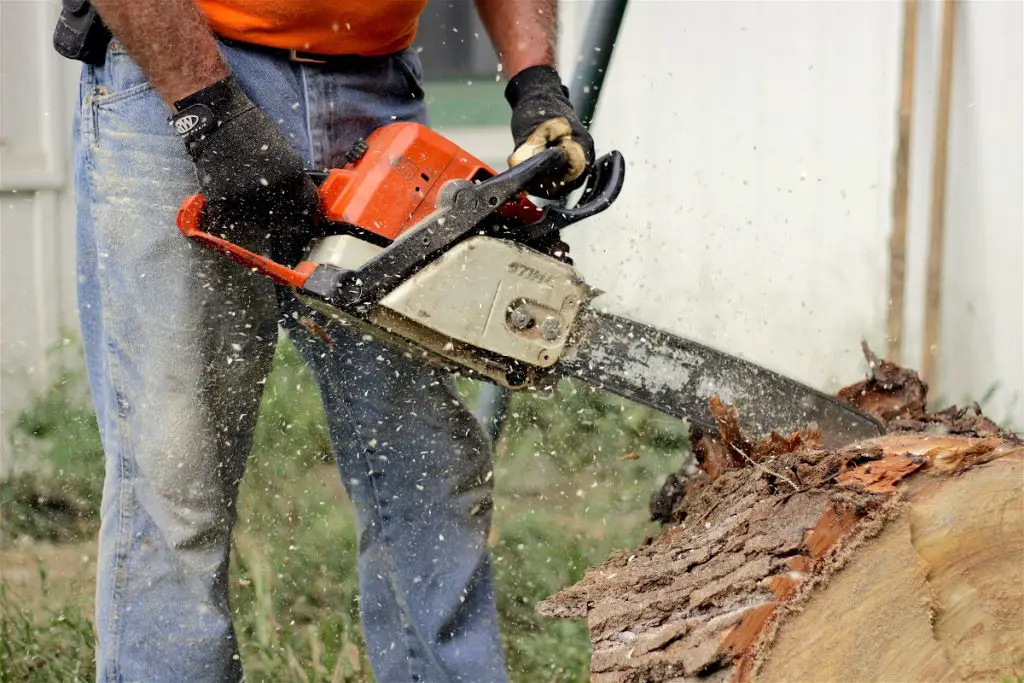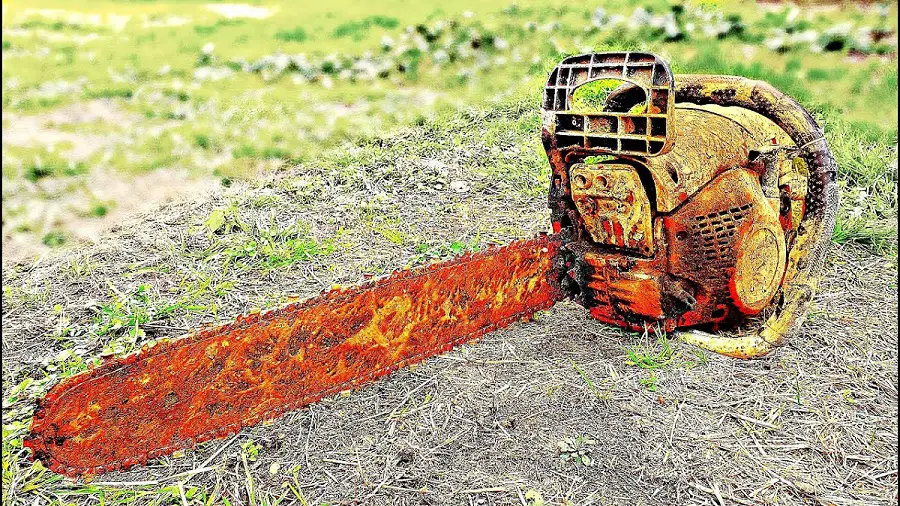Using a chainsaw in the rain is not recommended due to increased safety risks, such as reduced visibility, slippery surfaces, and potential electrical hazards. Additionally, wet conditions can cause damage to the chainsaw’s engine and electrical components. Always prioritize safety and use a chainsaw in dry conditions.
Heavy rain can create slippery conditions, which increases the risk of accidents and injuries. You also need to protect the chain and other components from rust, so while it is possible to use a chainsaw in the rain, there are some things you need to keep in mind.
Table of Contents
Running a Wet Chainsaw
Gas-powered chainsaws can typically operate in the rain without issue. However, you should not use electric chainsaws in the rain.
The battery and electrical components can get fried if exposed to enough water and moisture. While a light trickle of rain may not pose a serious risk, a heavy downpour could easily ruin an electric chainsaw.
Rain is unlikely to cause problems for a gas-powered chainsaw. Even a heavy downpour is unlikely to penetrate the interior of the chainsaw and damage the engine.
Yet chainsaws are not waterproof. Submerging a gas-powered chainsaw in water can destroy the engine. Water can interfere with the internal combustion process and permanently damage the chainsaw.
Do not operate a chainsaw that has been submerged in the water. Drain and refill the fuel tank. Dry the air filter. Dry and relubricate the chain and bar. Allow all other components to dry thoroughly before attempting to restart the chainsaw.

Cutting Wet Wood
I’ve noticed that it’s easier to cut wet wood than dry wood. The moisture acts as a lubricant.
Wet wood is difficult to burn but easy to cut as it creates less friction with the chain. Dry wood lacks moisture, which adds friction and slows your chain.
You can also use a standard chain in most situations when cutting wet wood. However, manufacturers also make chains designed specifically for cutting wet wood.
A wet wood chain is duller, which reduces friction. Common examples include chains with semi-chisel or rounded teeth. Remember that using a chain with duller teeth slows your cutting speed.
Preventing Rust
Rust is my main concern when using a chainsaw or other power tool in the rain. Rust is a potential issue when using a chainsaw to cut wet wood.
The combination of moisture, oxygen, and iron causes rust, which limits the performance of your chainsaw. Rust dulls the teeth of the chain and adds friction. The chain and bar may also weaken over time.
Use the following steps to protect your chainsaw from rust after using it in the rain or to cut wet wood:
- Dry the chainsaw
- Drain the fuel tank
- Remove the chain and bar
- Clean the inside of the cover
- Clean, dry, and lubricate the chain and bar
Start by drying the chainsaw with a rag or towel. You may also want to drain the fuel tank if you suspect that water may have gotten inside.
Unscrew the fuel cap. Drain the remaining fuel to a fuel can and dispose of it according to your local waste disposal requirements.
Place the chainsaw on a stable surface, such as a workbench. Setting it on a towel can help keep it from sliding around as you complete the remaining steps.
Most chainsaws include a removable panel that covers the base of the guide bar. Open the side panel and remove the guide bar and chain.
Use a brush to remove any buildup on the inside of the side panel. Sawdust and other debris will likely accumulate, especially after cutting wet wood.
You can clean the chain and bar if you notice buildup or have not cleaned them in a while. Getting material jammed in the chain is one of several reasons why a chainsaw may not work.
Use a putty knife to scrape debris from the guide bar. Soak the chain in a mixture of water and ammonia.
Thoroughly rinse and dry the chain and bar after cleaning. Ensure that the chain and bar are completely dry before lubricating the chain. A thin layer of oil can lubricate the chainsaw and protect against rust.

Safety Tips
According to the Centers for Disease Control (CDC), chainsaws cause about 36,000 injuries each year. Here are a few safety tips to keep in mind when operating a chainsaw in wet conditions:
- Double-check the fuel cap
- Wear proper attire
- Do not submerge the chainsaw in water
Always double-check the fuel cap to ensure it is secure before running the chainsaw in wet conditions. Any water inside the fuel tank can cause problems for your chainsaw.
Gasoline and water do not mix. Water sinks to the bottom of the fuel tank, as it is heavier than gasoline.
The engine starts taking in water after burning through the remaining gasoline. The water can cause the engine to stall or may eventually cause the pistons to break.
You should also dress appropriately when using a chainsaw in the rain or cutting wet wood. Wet conditions increase the risk of slippage. You may accidentally lose your grip on the chainsaw or lose your footing.
Wear boots that offer adequate grip when standing in muddy or slippery conditions. Wear chainsaw safety pants or chaps to shield your legs in the event of slippage. Other safety gear includes eye protection and gloves.
Do not let the engine drop below the water if you need to cut submerged wood. The chain can continue to cut below the water. Yet, as mentioned, submerging the engine may ruin your power tool.
Cutting submerged wood creates additional safety risks. A lack of visibility increases the risk of slipping and kickback. Limited visibility also makes it more difficult to detect debris. You may accidentally submerge the engine or allow water to penetrate the interior.
Conclusion
Using a gas chainsaw in the rain is not typically a problem. Using an electric chainsaw in the rain creates the risk of electrocution, shock, or damage to the tool.
Rust is the main concern when using a gas chainsaw in the rain. The moisture from rain and wet wood may corrode the chain and bar.
Always dry and lubricate the chain and bar after using a chainsaw in the rain or cutting wet wood.
